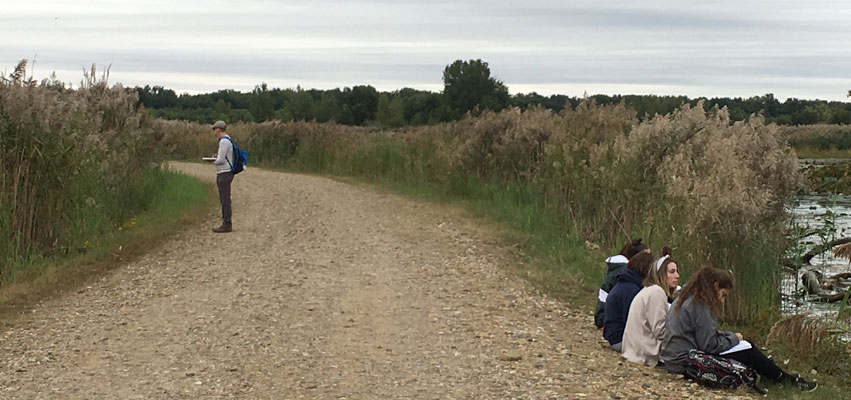Citizen science brings Bradley students into the community.
Students at Bradley University are learning firsthand how to participate in science that matters in their communities. Research projects measuring deer populations at Forest Park Nature Center and seasonal habitat change at Farmdale Reservoir allow college-age participants to engage directly with science and technology. In cooperation with Bradley’s Center for STEM Education, participants are conducting both short- and long-term studies on local ecosystems, allowing the development of long-term data sets that can be used to understand environmental change over time.
Hands-On Partnerships
A series of “Science Through Inquiry” courses were developed by Michelle Edgcomb Friday with input from faculty in the science and education departments at Bradley. The goal was to expand course offerings that engage pre-service teachers in science, allowing students to practice the inquiry approaches they should ultimately use in their own classrooms. Participants in these courses learn science content and scientific methods using technological tools and research approaches.
The research projects currently being used in these classes allow students to gain meaningful, hands-on experience while providing important data to community partners. Students explore experimental design and the technical aspects of data collection and analysis. Once in the field, they see how the data collected in these projects contributes to a broader knowledge base that describes the world around us. While these projects are great for engaging students at the college level, this type of project is equally meaningful to primary and secondary school students. Given that many of the participants are training to be elementary or middle-school teachers, the goal is to provide them examples of science that can be scaled for use with their own students.
This year, students in Science through Inquiry are contributing to an ongoing partnership with Forest Park Nature Preserve. In previous semesters, students have studied the biodiversity of plant species in areas of the preserve undergoing fire management. This year, the focus has expanded to include animal populations; the current study seeks to quantify the deer population within the preserve. This mutually beneficial arrangement allows students access to the expertise of park naturalists and the opportunity to explore otherwise inaccessible areas of the park, while providing data that can help inform management and conservation decisions.
While participants in the Forest Park study seek to answer a specific question, participants in the Farmdale Reservoir studies are starting with data collection and developing questions later. Farmdale Reservoir in Washington, Illinois, contains a wide variety of ecosystems in a small geographical area. As a result, participants can build a database of information that characterizes woodlands, tallgrass prairies, shortgrass prairies, savannas and aquatic systems. Measurements taken over the study’s two-month period include light quality, weather, biodiversity, soil composition and more. Toward the end of the study, participants will use database technologies to analyze their data and identify trends.

In SCI 302, students develop a better understanding of local ecosystems through extended observation.
A Saturday field trip allowed students to observe Banner Marsh.
Encouraging Citizen Scientists
Both research projects are examples of citizen science, in which non-scientists collect data as part of ongoing scientific studies. In addition to in-class studies, participants are encouraged to participate in citizen science projects outside of class as well. These projects are often sponsored by not-for-profit organizations throughout the state or nation, including FrogWatch USA (sponsored by the Association of Zoos and Aquariums), the Great Backyard Bird Count (sponsored by the National Audubon Society), the Illinois Butterfly Monitoring Network (sponsored by the Peggy Notebaert Nature Museum) and Illinois RiverWatch (sponsored by the National Great Rivers Research and Education Center).
In November, participants will present their preliminary data to local teachers at a Teacher Tuesday event hosted by the Center for STEM Education at Bradley University. These presentations will show how easy it is to get students of any age engaged in asking questions, planning and carrying out investigations, and developing a better understanding of the world through analysis of the results. The Teacher Tuesdays program, coordinated with the University of Illinois Extension and a host of other partners, aims to get local educators engaged directly in science, technology, engineering, art and mathematics (STEAM). As part of the Teacher Tuesday experience in November, teachers will develop and answer questions when they collaborate with a group of youth, allowing them to engage directly in STEAM activities.
If you are a teacher or know a teacher, Bradley faculty affiliated with the Center for STEM Education can help bring citizen science into your classroom. The Center also hosts a teacher loan program, with kits, equipment and supplies related to all areas of science which can be loaned out for several weeks at a time. For a full list of available materials, or to arrange for a loan, contact Dr. Sherri Morris, co-director of the Center for STEM Education, at [email protected].
If you are interested in engaging in a citizen science project yourself, you can learn about a variety of citizen science projects at www.dnr.illinois.gov/education/Pages/CitizenScience.aspx. FrogWatch USA, the Great Backyard Bird Count, the Illinois Butterfly Monitoring Network, Illinois RiverWatch and Project Squirrel are all projects which ask for citizens to count animals—but projects like CoCoRaHS (Community Collaborative Rain, Hail & Snow Network) require only that citizens have a rain gauge. iBi


